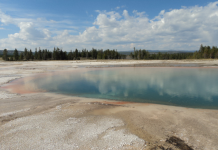The Biden-era ban on BLM coal leases has been overturned — On October 8, 2025, the U.S. Senate voted to nullify a Biden administration Bureau of Land Management (BLM) resource management plan amendment that had effectively banned new federal coal leases on approximately 1.7 million acres in eastern Montana’s Powder River Basin.
This amendment, finalized by the BLM’s Miles City field office in 2024, cited climate change concerns and declining coal demand as reasons for prohibiting future leasing beyond the existing Rosebud and Spring Creek mines.
The Senate’s action, taken under the Congressional Review Act (CRA), followed House approval last month and passed on a party-line vote, with Montana Republicans like Sen. Steve Daines and Sen. Tim Sheehy supporting it as a means to protect jobs, energy production, and local tax revenues.
The resolution now heads to President Donald Trump’s desk for expected signature, which would not only reverse the ban but also bar the BLM from issuing any substantially similar rule in the future.
A parallel CRA effort is underway for a similar BLM amendment in Wyoming’s portion of the Powder River Basin, where the Buffalo field office’s 2024 plan locked up nearly 50 billion short tons of coal from future mining.
Wyoming’s Republican delegation, including Sen. John Barrasso, Sen. Cynthia Lummis, and Rep. Harriet Hageman, introduced legislation on October 8 to overturn it, criticizing the Biden-era rule as an attack on energy independence and local economies.
Democrats have opposed these moves, arguing they undermine extensive public input processes and could create legal uncertainty for land use permits.
Separately, on October 10, 2025, the BLM rejected the sole bid in a Montana coal lease sale — $186,481.59 from an unnamed company — for failing to meet Mineral Leasing Act requirements, while also postponing a planned Wyoming coal auction. This occurred amid the ongoing CRA process, suggesting the full effects of the overturn have not yet taken hold.
Details on Mineral Leasing Act Requirements
The Mineral Leasing Act of 1920 (MLA), as amended (most recently through P.L. 119-21 on July 4, 2025), governs the leasing of federal public domain lands for the extraction of certain minerals, including coal, oil, gas, phosphate, sodium, potassium, oil shale, gilsonite, and sulfur. It authorizes the Secretary of the Interior (typically through the Bureau of Land Management, or BLM) to issue leases while ensuring public interest, environmental protection, fair market returns, and compliance with other laws.
The Act applies to U.S. citizens, associations, corporations, and municipalities, but prohibits foreign entities from countries that deny reciprocal privileges to Americans. Below is a breakdown of key requirements, focusing on coal leasing on federal lands, drawn from the Act’s provisions.
Bidding Processes and Bid Evaluation
Federal coal leases are generally issued through competitive bidding to ensure fair market value (FMV) and public benefit. Key requirements include:
-
- Lands classified as containing coal must be divided into leasing tracts based on economic recoverability and public interest. At least 50% of annual leased acreage must use a deferred bonus payment system.
- Leases are offered via public notice (published weekly for three weeks in a local newspaper) and require public hearings in the affected area.
- Bids must be competitive, with no acceptance of offers below the Secretary-determined FMV, which incorporates public comments but does not require pre-issuance disclosure of the determination. The Secretary evaluates bids to confirm they meet or exceed FMV, rejecting those that do not.
- In recent context, such as the October 2025 Montana coal lease sale for a tract in Big Horn County (estimated at 167.5 million tons of recoverable coal), the BLM rejected a sole bid of $186,481.59 from Navajo Transitional Energy Company (NTEC) because it failed to meet MLA requirements — specifically, it did not represent FMV (equivalent to about 0.1 cents per ton, underscoring coal’s declining market value).
- Exceptions allow negotiated sales at FMV for incidental coal removal tied to rights-of-way, but competitive bidding is the norm. If identical high bids occur, tying bidders may be required to rebid.
- A Wyoming lease sale planned for the same period was postponed amid similar low-interest concerns, highlighting broader industry challenges.
Qualifications for Lessees
-
- Applicants must be “responsible qualified bidders” under the Act, demonstrating technical and financial capability. This includes U.S. citizens or entities, with restrictions on railroads (limited to their own use, up to 10,240 acres total) and entities holding non-producing leases for 10+ years (barring new acquisitions unless exceptions apply).
- Antitrust review is mandatory: The Secretary consults the Attorney General before issuance, renewal, or readjustment to avoid violations, potentially requiring public hearings.
- Disclosure of ownership (e.g., partners, shareholders with 3%+ voting shares) is required. No leases on wilderness study areas or certain restricted lands unless compatible with preservation.
- Exploration licenses (up to 2 years) are needed for pre-leasing activities, with conditions to minimize disturbance and no automatic right to a lease.
Lease Terms
-
- Duration: 20 years, renewable if producing commercial quantities of coal annually; non-producing leases terminate after 10 years.
- Acreage limits: Up to 2,560 acres per lease (contiguous or operable as a single unit); aggregate holdings capped at 75,000 acres per state or 150,000 nationwide per entity (including affiliates).
- Diligent development: Lessees must pursue operations diligently, with possible suspensions for public interest (e.g., conservation), but advance royalties apply during halts.
- Logical mining units: Leases can consolidate into units up to 25,000 acres (including non-federal lands) for efficient mining, requiring full reserves extraction within 40 years (extendable).
- Modifications: Existing leases can add contiguous lands (up to 960 acres) if in public interest and without displacing competitors.
- Operations and reclamation plans must be submitted and approved before significant surface disturbance, with consent from other federal agencies if they manage the surface.
Rentals
-
- Annual advance rentals, credited against royalties, start at rates prescribed by regulation (e.g., historically 25 cents/acre year 1, rising to $1/acre after year 5 for similar minerals).
- For deferred bonus bids, no surety bond is required if the lessee has a history of timely payments; defaults lead to automatic termination without refunds.
- Waivers or reductions possible to promote development or conservation, but not for advance royalties.
Royalties
-
- Minimum rate: Not less than 12.5% of coal value (reducible to 7% through September 30, 2034, or lower for underground mining).
- Minimum annual production or royalty required, except during excused interruptions (e.g., strikes).
- Re-adjustable every 20 years (then every 10 years if extended). Advance royalties during suspensions are based on spot market prices and creditable against future production.
- Revenue distribution: 50% to the state (prioritizing impacted areas), 40% to a reclamation fund, remainder to federal miscellaneous receipts (with variations for Alaska).
Environmental Compliance
-
- Leases must align with comprehensive land-use plans assessing recoverable coal, environmental impacts, and alternatives (e.g., surface vs. deep mining). Public input and state/local consultations are required.
- Provisions mandate compliance with the Federal Water Pollution Control Act, Clean Air Act, and other laws. Operations must prevent waste, protect miners’ welfare (e.g., 8-hour workday, no child labor under 16 underground), and include reclamation bonds.
- Environmental impact evaluations consider effects on communities, agriculture, economy, and services; plans must mitigate damage.
- Exploration and rights-of-way (e.g., for pipelines) require NEPA compliance, erosion control, revegetation, and protection of air/water quality, health, and subsistence resources.
Other Key Requirements
-
- Production in commercial quantities: Mandatory after 10 years to maintain the lease.
- Forfeiture and penalties: Leases can be canceled for noncompliance (e.g., after 30 days’ notice), with fines up to $1,000/day for unauthorized exploration or up to $500,000 plus imprisonment for fraud.
- Rights-of-way: Granted for related infrastructure (e.g., coal transport pipelines) up to 30 years, with common carrier obligations and environmental safeguards.
- Enforcement: Includes judicial review limits (e.g., 90 days for challenges) and state involvement in civil actions.
- Data handling: Exploration data remains confidential until leasing, with public geological reports required.
These requirements aim to balance resource development with fiscal responsibility and environmental stewardship. For full text, refer to the compiled Act.
In practice, as seen in the 2025 Montana rejection, FMV enforcement prevents speculative or undervalued leasing, reflecting coal’s economic decline.






